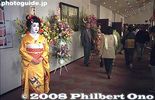23rd Asakusa Odori Geisha Dance 第23回 浅草おどり
|
|
|

Asakusa Kokaido Hall in Asakusa, Tokyo, venue of the 23rd Asakusa Odori geisha dance held on Oct. 28-29, 2008. It has been seven years since the last time the Asakusa Odori was held in April 2001. 浅草公会度
|
|

Asakusa Odori banner in front of Asakusa Kokaido. The 1st Asakusa Odori (called Asaji-kai 浅茅会) was held in 1950 for four days at the old Sumida Gekijo Hall. It was held annually until 1956. After that, it was held every 2 years or less often.
|
|

Entrance to Asakusa Kokaido and Asakusa Odori sign. In the 1950s, there were 550 geisha in Asakusa. Now there are only about 49 geisha in Asakusa. Not all of them appeared in the Asakusa Odori. The Asaji-kai dance was renamed Asakusa Odori in 1995.
|
|

Asakusa Odori flyer/poster. Two shows (11:30 am and 3 pm) were performed on both days, for a total of four shows. Tickets cost 6,500 yen for reserved seats and 2,000 yen for non-reserved on the 3rd floor.
|
|

Reception table backed by a board listing various corporate sponsors. I attended the final show on Oct. 29, 2008 at 3 pm.
|
|

Stairway to the hall.
|
|

A side attraction was a tea session (ocha-seki) performed and served by two geisha (or hangyoku). It cost 700 yen for tea and sweets. お茶席
|
|

Hall lobby (Get that trash bin outta there.)
|
|

The 2nd floor had a booth selling Asakusa geisha souvenirs. The dance program was 1,000 yen.
|
|

A hand towel with the names of all the current Asakusa geisha was selling for 1,500 yen. They also had T-shirts.
|
|

Name cards of all the geisha were sold for 100 yen apiece.
|
|

Name cards of all 49 Asakusa geisha.
|
|

The dance consisted of four numbers. The first one was called Sara Sanban-so (晒三番叟) which was first performed in Edo in Nov. 1755. 宝暦5年
|
|
|
|
|
|
|
|
|
|

There were only four dancers, but they went through several costume changes onstage.
|
|
|
|
|
|
|
|
|
|
|
|
|
|
|
|
|

Waving these white streamers created a dazzling visual effect. It must have been either the wind or river.
|
|
|
|

For the second number, there was a little stage for the musicians and singers on the right of the stage.
|
|
|

The second number was called Matsuri (Festival). It featured these three young village girls and two geisha dancers. 藤間流 まつり
|
|
|
|
|
|
|
|
|
|
|
|
|
|
|
|
|
|
|
|
|
|
|

The third number was called 三枚続花の姿絵 and consisted of three parts. The first part was called 星月夜 which means "Night of Stars and Moon."
|
|
|

These six geisha dressed as young maidens make their first-time appearance in the Asakusa Odori.
|
|
|
|
|
|

With a dark background, the geisha seemed to glow in the dark.
|
|
|
|
|
|
|
|
|
|
|
|

Sank into the stage to disappear.
|
|

The second part of 三枚続花の姿絵 was called Hagi no Hanazuma 萩の花妻 which means Bush Clover Flower Lady.
|
|

A more mature woman appears for this part set in autumn.
|
|
|

She left the stage this way.
|
|

The third part of 三枚続花の姿絵 was called Hana no Shojo 花の猩々 which means Flowery Heavy Drinker. This play comes from a Noh play.
|
|

The play is set during the cherry blossom season.
|
|
|

Three red-haired lions.
|
|
|
|
|
|
|
|
|
|

Drinking sake
|
|
|
|
|
|
|
|

The three red lions were nice, but they didn't swing their hair round and round like in kabuki.
|
|
|
|

On the hanamichi
|
|
|
|

Then there was a 20-min. intermission which featured a comedic trio.
|
|

I took the intermission time to photograph an Asakusa geisha.
|
|

Lobby
|
|

The fourth and final number was the Finale called 江戸の心浅茅の賑い which consisted of six parts. They performed their zashiki dances.
|
|

The Finale's first part was called Namiki Komagata-Koi no Asakusa 並木駒形 恋の浅草
|
|
|
|

Dancing on the hanamichi
|
|
|
|
|
|
|

The third part of the Finale. 五万石
|
|

Fourth part of the Finale. 笠森おせん
|
|
|

Last part of the Finale called Asakusa Meibutsu-Sawagi when they all came out dancing on the stage and hanamichi. 浅草名物 さわぎ
|
|
|
|
|
|
|
|
|
|

Then they all sat and started to bow. It was really an outstanding performance.
|
|

Asakusa geisha bowing to the audience in three directions. Bravo!
|
|

Since this was the final show (Oct. 29, 2008 at 3 pm), they all appeared on the stage with the organizers and said a few words.
|
|

Asakusa Odori organizer speaks to thank the audience. He said that people looked forward to seeing the next Asakusa Odori next year, but he said, "There won't be one next year."
|
|
|
|

At the end, we clapped in celebration. The show was 2.5 hours long, including a 10-min. and 20-min. intermission.
|
|

Asakusa hangyoku (apprentice geisha in Tokyo). 半玉 千福
|
|

Asakusa hangyoku (apprentice geisha in Tokyo). 半玉 こず江
|
|

I also saw the 22nd Asakusa Odori held in April 2001 at the Asakusa Kokaido. The lobby had two hangoyku greeting the audience.
|
|

Asakusa hangyoku (apprentice geisha in Tokyo) named Ichigo posing in April 2001. 半玉
|
|

22nd Asakusa Odori, April 2001.
|
|
|
|
|